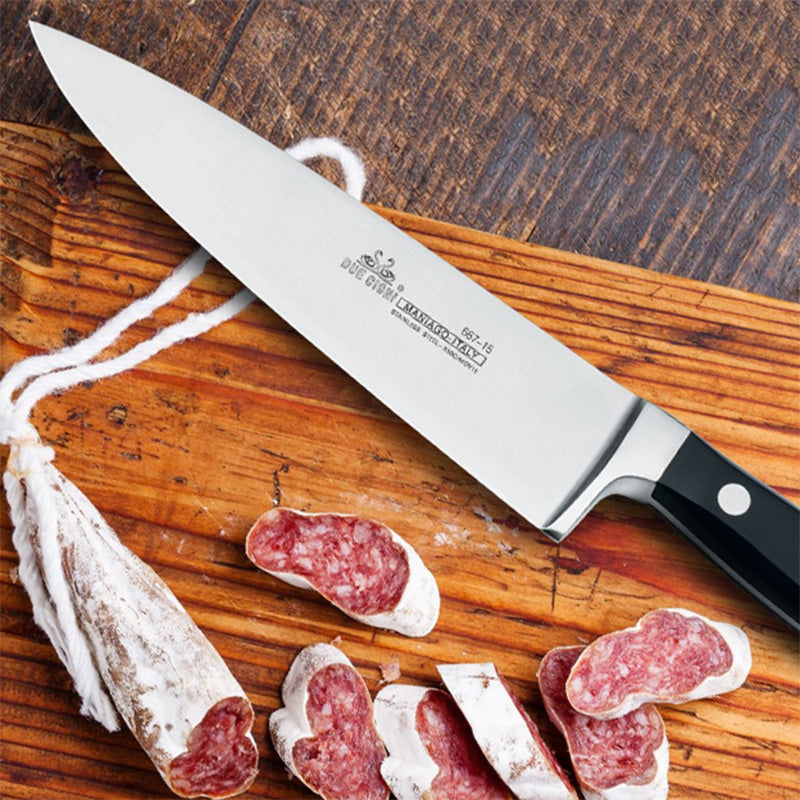Classica Santoku Knife with Scallops
Due Cigni’s Classica 7” Full Tang Knife with Scallops is a high quality knife designed for precision cutting.
The scallops on this knife help it release food as you slice. If you need really thin cuts you should use Due Cigni’s santoku knife rather than Due Cigni’s chef knife. Due Cigni’s 7” Full Tang Santoku Knife with Scallops is best for cutting meats, slicing cheese, and slicing, chopping or dicing fruits, nuts, and vegetables. Santoku means “three virtues”; slicing, dicing, and chopping.
What is a scalloped Santoku knife used for?
A scalloped Santoku knife, with its unique indentations along the blade, is designed to minimize sticking and create air pockets. This feature is particularly useful for thinly slicing sticky foods like cheese and vegetables. The scallops help release food easily, making the knife ideal for precise and clean cuts.
Click To Read All FAQS
Why are knives scalloped?
Knives are scalloped, featuring shallow grooves along the blade, to reduce friction and sticking when slicing. These scallops, or grantons, create air pockets, allowing food to release easily from the blade. This design is especially beneficial for slicing sticky or wet foods, ensuring smoother, cleaner cuts with less effort.
What is the purpose of the divots on a Santoku knife?
The divots, or granton edge, on a Santoku knife serve to reduce food sticking to the blade. These shallow indentations create air pockets, allowing thin slices to release more easily. This feature enhances the knife's precision and efficiency, especially when slicing sticky or wet ingredients.
How often do you need to sharpen a Santoku knife?
The frequency of sharpening a Santoku knife depends on usage. For regular home cooks, sharpening every 3-6 months is sufficient. Professional chefs may need to sharpen more frequently. Regular honing between sharpenings helps maintain the edge, extending the time between full sharpening sessions.
What angle should a Santoku knife be?
A Santoku knife should be sharpened at an angle of 15 to 20 degrees on each side. This angle provides a sharp, efficient cutting edge, suitable for the fine slicing, dicing, and mincing tasks that Santoku knives excel at. Maintaining this angle ensures optimal performance and longevity of the blade.
What do you chop with a Santoku knife?
A Santoku knife is ideal for chopping a variety of foods, including vegetables, fruits, meats, and fish. Its sharp blade and balanced design make it perfect for fine chopping, dicing, and mincing. The wide blade also helps in scooping chopped ingredients, enhancing its versatility in the kitchen.
Is Santoku knife good for meat?
Yes, a Santoku knife is excellent for cutting meat. Its sharp, versatile blade is ideal for slicing, dicing, and mincing boneless meats with precision and ease. While it's not suitable for cutting through bones, it performs exceptionally well with various types of meat, making it a valuable kitchen tool.
Can a Santoku knife cut through bone?
No, a Santoku knife is not designed to cut through bone. Its blade is crafted for precision slicing, dicing, and mincing, particularly with vegetables, fruits, and boneless meats. For cutting through bone, a heavier, more robust knife like a cleaver or a specialized meat knife is recommended.
What is the difference between a chef's knife and Santoku?
The primary difference lies in their design and versatility. A chef's knife, typically 6-12 inches long, has a curved blade, making it ideal for a rocking motion. In contrast, a Santoku, usually 5-7 inches, has a straighter edge and is better for precise, downward cuts and thin slicing.
Can you use a Santoku knife for everything?
"While a Santoku knife is highly versatile, it's not ideal for every task. It excels in slicing, dicing, and mincing, especially for vegetables, fruits, and boneless meats. However, it's not suited for heavy-duty tasks like cutting through bones or very hard foods, where specialized knives would be better."
Do professional chefs use Santoku knives?
Yes, many professional chefs use Santoku knives for their precision and versatility. Known for their sharpness and balanced handling, these knives are excellent for slicing, dicing, and mincing. Chefs appreciate their efficiency in preparing a variety of ingredients, making them a staple in both Western and Asian cuisines.
Blade Steel: stainless steel 4116 X50CrMoV15
Hardness: HRC 55-57
Blade Coating: satin
Handle: black POM
Rivets: stainless steel
Blade Length: 18 cm – 7.09″
Overall Length: 30 cm – 11.81″
Blade Thickness: 2 mm – 0.08″
SHIPPING
Most orders will be processed within one business day (we make sure our employees take Saturday and Sunday off, so if you order late Friday or over the weekend, we will process your order on Monday). When your order leaves our warehouse in Seattle, Washington, you will receive an email with your tracking number. Add 3 to 5 business days for delivery. Please note that we only ship within the United States.
RETURNS POLICY
We take pride in our workmanship and stand behind our products, which is why we accept returns within the first 30 days from the day your items arrive.
Collections
Products
Blogs





 Classica 7 Inch Full Tang Santoku Kitchen Knife with Scallops
Classica 7 Inch Full Tang Santoku Kitchen Knife with Scallops

 DueCigni Cutlery
DueCigni Cutlery

 DueCigni Cutlery
DueCigni Cutlery